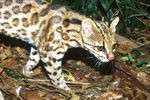The thin-spined porcupine, also known as the bristle-spined rat, is a truly distinct animal: a sort of cross between New World porcupines and spiny rats with genetic research showing it is slightly closer to the former rather than the latter. But the thin-spined porcupine (Chaetomys subspinosus), found only in Brazil’s Atlantic Forest, is imperiled by human activities. In fact, a new study in mongabay.com’s open access journal Tropical Conservation Science found that the species remains a target for hunters, despite a reputation for tasting terrible.
Conducting 125 interviews with people living both illegally and legally in two protected areas—Una Wildlife Refuge and the Serra do Conduru State Park—the scientists found that only half of the respondents could accurately identify the species. Those that could generally had a low opinion of the taste of thin-spined porcupine meat. In addition, some taboos have risen about thin-spined porcupine meat. But hunting still poses a grave risk to the species.
“Although its meat is not coveted throughout the study area, the main reason for hunting it is for food,” the researchers write. “Another motivation for hunting is for medicinal uses. Some respondents in both areas have cited using the thin-spined porcupine’s quills to treat diseases, especially strokes, and to improve the accuracy of hunting dogs.”
 Thin-spined porcupine. Photo by: Gaston Giné/Castilho et al. |
The thin-spined porcupine shares its habitat with a more common and well-known porcupine, Bahia hairy dwarf porcupine (Sphiggurus insidiosus). Although sometimes confused with each other, the two porcupines are actually quite different. The thin-spined porcupine, whose spines are more like bristles and less likely to cause injury, is so distinct that not only does it belong to its own genus, but also its own subfamily.
In addition to hunting, other activities are likely hurting thin-spined porcupines in the two parks including cutting down secondary forests, wood extraction, burning, and stealing wild animals—several respondents said that young thin-spined porcupines made good pets.
In order to protect the thin-spined porcupine, which is considered Vulnerable by the IUCN Red List, the researchers say conservation program should focus on the people in the area, many of whom are poor.
“More attention should be paid to local residents living inside and around these protected areas. Dependence on wildlife resources, especially among farmers and agriculture dependents, must be reduced through livelihood security,” the write, adding that education efforts “should focus on rural residents, especially men, who have negative attitudes toward wildlife conservation. Particularly, hunters and consumers should be educated about how overhunting threatens both biodiversity and rural livelihoods ”
Brazil’s Atlantic Forest remains one of the most imperiled in the world. Only around 7 percent of the original forest is left and what remains is often found in fragmented pockets, hugely imperiled by encroaching development and hunting. Many of the Atlantic Forests’ big animals have already been driven to local extinction, but a number of species found no-where else are still hanging on, like the thin-spined porcupine.
Citations:
- Castilho, L. C., Martinez, R.A., Giné, G. A. F., Ribeiro, G. C., and Schiavetti, A. 2013. The thin-spined porcupine, Chaetomys subspinosus (Rodentia: Erethizontidae), within protected areas in the Atlantic Forest, Brazil: local knowledge and threats. Tropical Conservation Science Vol.6 (6):796-810.
Related articles
Scientists discover new cat species roaming Brazil

(11/27/2013) As a family, cats are some of the most well-studied animals on Earth, but that doesn’t mean these adept carnivores don’t continue to surprise us. Scientists have announced today the stunning discovery of a new species of cat, long-confused with another. Looking at the molecular data of small cats in Brazil, researchers found that the tigrina—also known as the oncilla in Central America—is actually two separate species. The new species has been dubbed Leopardus guttulus and is found in the Atlantic Forest of southern Brazil, while the other Leopardus tigrinus is found in the cerrado and Caatinga ecosystems in northeastern Brazil.
Forest fragmentation leading to higher extinction rates

(08/13/2013) The world’s species are in worse trouble than widely-assumed, according to a new paper in the Proceedings of the National Academy of Sciences (PNAS), which reevaluates how scientists estimate extinction rates. The new model takes into account the impact of forest fragmentation on extinction rates for the first time, filling in a gap in past estimates. Much of the world’s tropical forests, which house the bulk of the world’s species, have been whittled down to fragments: small forest islands that no longer connect to larger habitat. According to the paper, species confined to fragments have a higher likelihood of vanishing.
On guard: protecting wildlife in a heavily hunted Brazilian forest
(06/24/2013) The Brazilian government offers tax relief to landowners who set aside areas for preservation. While this has expanded the system of private ecological reserves considerably, the Brazilian government currently lacks funding to enforce the protection of these lands from threats such as hunting, leaving the responsibility to the landowners.
Loss of big fruit-eating birds impacting trees in endangered rainforests
(05/31/2013) The extinction of large, fruit-eating birds in fragments of Brazil’s Atlantic rainforest has caused palm trees to produce smaller seeds over the past century, impacting forest ecology, finds a study published in the journal Science.
New insect discovered in Brazil, only third known in its bizarre family (photos)

(04/15/2013) A new species of forcepfly named Austromerope brasiliensis, was recently discovered in Brazil and described in the open access journal Zoo Keys. This is the first discovery of forcepfly in the Neotropics and only the third known worldwide. The forcepfly, often called the earwigfly because the male genital forceps closely resemble the cerci of the common earwig, remains a scientific enigma due to the lack of information on the family.
New species tree-dwelling porcupine discovered in critically threatened Brazilian habitat
(04/11/2013) Scientists in Brazil have described a new species of tree-dwelling porcupine in the country’s most endangered ecosystems. The description is published in last week’s issue of Zootaxa.